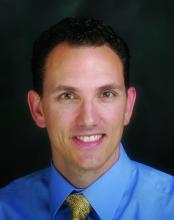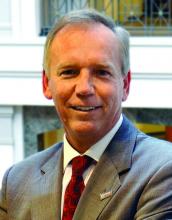User login
Take a look at the HM16 program, and you get a snapshot of the most pressing topics in hospital medicine. Specifically, four new educational tracks are being rolled out at this year’s annual meeting, including a new track on the patient-doctor relationship, which is so crucial with today’s growing emphasis on patient satisfaction, and a track focused on perioperative medicine, an important area with a fast-moving frontier. Another new track covers post-acute care, a setting in which more and more hospitalists find themselves practicing. Then there’s the big daddy: health information technology (IT) for hospitalists.
Course Director Melissa Mattison, MD, SFHM, also points to a new twist in the way the conference will attempt to tackle the tough topic of work-life balance.
Read the full interview with Melissa Mattison, MD, SFHM.
Here’s a look at what’s new for HM16 attendees.
Health IT for Hospitalists
“There’s not a hospitalist in the country who’s not affected by IT and updates to their [electronic medical records (EMR)], new adoption of EMR technology, different vendors,” Dr. Mattison says. “We’re always searching for something to make our lives better and make the care that we provide more high quality.”
There will be sessions of a general nature, such as “There’s an App for That,” a review of mobile apps helpful to hospitalists. And there will be those for the more passionate technophiles, such as a session on clinical informatics and “Using IT to Help Drive the Shift from Volume to Value.”
“We’ve spent a lot of time trying to make sure there’s something for everyone,” says Kendall Rogers, MD, SFHM, chair of SHM’s IT Committee. “And even within each individual talk, we’ve tried to make sure that there is material that can be applicable from the frontline hospitalist to the CMIO of a hospital.”
Dr. Rogers says the committee has “really been pushing” to have its own track at the annual meeting.
Listen to more of our interview with Dr. Rogers.
“Health IT continues to be an area of great frustration and great promise,” he says. “I think most of the frustration that hospitalists have is because they realize the potential of health IT, and they see how far it is from the reality of what they’re working with every day.
“Hospitalists are well-suited for actively being involved in clinical informatics, but many of us would be far more effective in our roles with more formal education and training.”
Post-Acute Care
It’s estimated that as many as 35% of hospitalists work in the post-acute setting. The number very much surprised Dr. Mattison. When she heard of the figure, “[the committee] lobbied very hard to get a track for post-acute care.”
One session, “Building and Managing a PAC Practice,” will review setting up a staff, relevant regulations, billing, and collecting, and it should be of interest to both managers and physicians, says Sean Muldoon, MD, senior vice president and chief medical officer of the hospitalist division at Louisville, Ken.–based Kindred Healthcare and chair of SHM’s Post-Acute Care Task Force.
Another session, “Lost in Transitions,” will review information gaps and propose solutions “to the well-known voltage drop of information that can happen in transfer from the hospital to post-acute care.”
At Kindred, Dr. Muldoon says he has seen the benefits of hospitalist involvement in post-acute care.
“In many markets, we seek out and often are able to become a practice site for a large hospitalist medical group,” he says. “That’s really good for us, the patients, and, we think, the hospitalists because it allows the hospitalists to be exposed to the practice and benefits of post-acute care without having to make a full commitment to be a skilled-nursing physician or a long-term acute-care physician.”
It also makes transitions of care smoother and less disruptive, he says, “because a patient is simply transferred from one hospitalist in a group to another or often maintaining that same hospitalist in the post-acute-care setting.”
Dr. Muldoon says the new track is of value to any hospitalist, whether they actually work in post-acute care or not.
“A hospitalist would be hard-pressed to provide knowledgeable input into where a patient should receive post-acute care without a working knowledge of which patients should be directed to which post-acute-care setting,” he says.
Doctor-Patient Relationship
This topic was a pre-course last year, and organizers decided to make this a full track on the final day of the meeting schedule.
“It’s really about communication style,” Dr. Mattison says. “There’s one session called ‘The Language of Empathy and Engagement: Communication Essentials for Patient-Centered Care.’ There’s one on unconscious biases and our underlying assumptions and how it affects how we care for patients. [Another is focused] on improving the patient experience in the hospital.”
Co-Management/ Perioperative Medicine
“There are a lot of challenges around anticoagulation management, optimizing patients’ physical heath prior to the surgery, what things should we be doing, what medications should we be giving, what ones shouldn’t we be giving,” Dr. Mattison says. “It’s an evolving field that has, every year, new information.”
Hidden Gems
Dr. Mattison draws special attention to “Work-Life Balance: Is It Possible?” (Tuesday, March 8, 4:20–5:40 p.m.). This year, this problem—all too familiar to hospitalists—will be addressed in a panel discussion, which is a change from previous years.
“There’s been, year after year after year, a lot of discussion around, how can I make my job manageable if my boss isn’t listening to me or is not attuned to work-life balance? How can I navigate this process?” she says. “I’m hopeful that the panel discussion will provide people with some real examples and strategies for success.”
She also draws attention to the session “Perioperative Pitfalls: Overcoming Common Challenges in Managing Medical Problems in Surgical Patients” (Monday, March 7, 3:05–4:20 p.m.).
“There are some true leaders in perioperative management, and they’re going to come together and have a panel discussion,” she says. “It’ll be an opportunity to see some of the great minds think, if you will.” TH
Thomas R. Collins is a freelance writer in South Florida.
Take a look at the HM16 program, and you get a snapshot of the most pressing topics in hospital medicine. Specifically, four new educational tracks are being rolled out at this year’s annual meeting, including a new track on the patient-doctor relationship, which is so crucial with today’s growing emphasis on patient satisfaction, and a track focused on perioperative medicine, an important area with a fast-moving frontier. Another new track covers post-acute care, a setting in which more and more hospitalists find themselves practicing. Then there’s the big daddy: health information technology (IT) for hospitalists.
Course Director Melissa Mattison, MD, SFHM, also points to a new twist in the way the conference will attempt to tackle the tough topic of work-life balance.
Read the full interview with Melissa Mattison, MD, SFHM.
Here’s a look at what’s new for HM16 attendees.
Health IT for Hospitalists
“There’s not a hospitalist in the country who’s not affected by IT and updates to their [electronic medical records (EMR)], new adoption of EMR technology, different vendors,” Dr. Mattison says. “We’re always searching for something to make our lives better and make the care that we provide more high quality.”
There will be sessions of a general nature, such as “There’s an App for That,” a review of mobile apps helpful to hospitalists. And there will be those for the more passionate technophiles, such as a session on clinical informatics and “Using IT to Help Drive the Shift from Volume to Value.”
“We’ve spent a lot of time trying to make sure there’s something for everyone,” says Kendall Rogers, MD, SFHM, chair of SHM’s IT Committee. “And even within each individual talk, we’ve tried to make sure that there is material that can be applicable from the frontline hospitalist to the CMIO of a hospital.”
Dr. Rogers says the committee has “really been pushing” to have its own track at the annual meeting.
Listen to more of our interview with Dr. Rogers.
“Health IT continues to be an area of great frustration and great promise,” he says. “I think most of the frustration that hospitalists have is because they realize the potential of health IT, and they see how far it is from the reality of what they’re working with every day.
“Hospitalists are well-suited for actively being involved in clinical informatics, but many of us would be far more effective in our roles with more formal education and training.”
Post-Acute Care
It’s estimated that as many as 35% of hospitalists work in the post-acute setting. The number very much surprised Dr. Mattison. When she heard of the figure, “[the committee] lobbied very hard to get a track for post-acute care.”
One session, “Building and Managing a PAC Practice,” will review setting up a staff, relevant regulations, billing, and collecting, and it should be of interest to both managers and physicians, says Sean Muldoon, MD, senior vice president and chief medical officer of the hospitalist division at Louisville, Ken.–based Kindred Healthcare and chair of SHM’s Post-Acute Care Task Force.
Another session, “Lost in Transitions,” will review information gaps and propose solutions “to the well-known voltage drop of information that can happen in transfer from the hospital to post-acute care.”
At Kindred, Dr. Muldoon says he has seen the benefits of hospitalist involvement in post-acute care.
“In many markets, we seek out and often are able to become a practice site for a large hospitalist medical group,” he says. “That’s really good for us, the patients, and, we think, the hospitalists because it allows the hospitalists to be exposed to the practice and benefits of post-acute care without having to make a full commitment to be a skilled-nursing physician or a long-term acute-care physician.”
It also makes transitions of care smoother and less disruptive, he says, “because a patient is simply transferred from one hospitalist in a group to another or often maintaining that same hospitalist in the post-acute-care setting.”
Dr. Muldoon says the new track is of value to any hospitalist, whether they actually work in post-acute care or not.
“A hospitalist would be hard-pressed to provide knowledgeable input into where a patient should receive post-acute care without a working knowledge of which patients should be directed to which post-acute-care setting,” he says.
Doctor-Patient Relationship
This topic was a pre-course last year, and organizers decided to make this a full track on the final day of the meeting schedule.
“It’s really about communication style,” Dr. Mattison says. “There’s one session called ‘The Language of Empathy and Engagement: Communication Essentials for Patient-Centered Care.’ There’s one on unconscious biases and our underlying assumptions and how it affects how we care for patients. [Another is focused] on improving the patient experience in the hospital.”
Co-Management/ Perioperative Medicine
“There are a lot of challenges around anticoagulation management, optimizing patients’ physical heath prior to the surgery, what things should we be doing, what medications should we be giving, what ones shouldn’t we be giving,” Dr. Mattison says. “It’s an evolving field that has, every year, new information.”
Hidden Gems
Dr. Mattison draws special attention to “Work-Life Balance: Is It Possible?” (Tuesday, March 8, 4:20–5:40 p.m.). This year, this problem—all too familiar to hospitalists—will be addressed in a panel discussion, which is a change from previous years.
“There’s been, year after year after year, a lot of discussion around, how can I make my job manageable if my boss isn’t listening to me or is not attuned to work-life balance? How can I navigate this process?” she says. “I’m hopeful that the panel discussion will provide people with some real examples and strategies for success.”
She also draws attention to the session “Perioperative Pitfalls: Overcoming Common Challenges in Managing Medical Problems in Surgical Patients” (Monday, March 7, 3:05–4:20 p.m.).
“There are some true leaders in perioperative management, and they’re going to come together and have a panel discussion,” she says. “It’ll be an opportunity to see some of the great minds think, if you will.” TH
Thomas R. Collins is a freelance writer in South Florida.
Take a look at the HM16 program, and you get a snapshot of the most pressing topics in hospital medicine. Specifically, four new educational tracks are being rolled out at this year’s annual meeting, including a new track on the patient-doctor relationship, which is so crucial with today’s growing emphasis on patient satisfaction, and a track focused on perioperative medicine, an important area with a fast-moving frontier. Another new track covers post-acute care, a setting in which more and more hospitalists find themselves practicing. Then there’s the big daddy: health information technology (IT) for hospitalists.
Course Director Melissa Mattison, MD, SFHM, also points to a new twist in the way the conference will attempt to tackle the tough topic of work-life balance.
Read the full interview with Melissa Mattison, MD, SFHM.
Here’s a look at what’s new for HM16 attendees.
Health IT for Hospitalists
“There’s not a hospitalist in the country who’s not affected by IT and updates to their [electronic medical records (EMR)], new adoption of EMR technology, different vendors,” Dr. Mattison says. “We’re always searching for something to make our lives better and make the care that we provide more high quality.”
There will be sessions of a general nature, such as “There’s an App for That,” a review of mobile apps helpful to hospitalists. And there will be those for the more passionate technophiles, such as a session on clinical informatics and “Using IT to Help Drive the Shift from Volume to Value.”
“We’ve spent a lot of time trying to make sure there’s something for everyone,” says Kendall Rogers, MD, SFHM, chair of SHM’s IT Committee. “And even within each individual talk, we’ve tried to make sure that there is material that can be applicable from the frontline hospitalist to the CMIO of a hospital.”
Dr. Rogers says the committee has “really been pushing” to have its own track at the annual meeting.
Listen to more of our interview with Dr. Rogers.
“Health IT continues to be an area of great frustration and great promise,” he says. “I think most of the frustration that hospitalists have is because they realize the potential of health IT, and they see how far it is from the reality of what they’re working with every day.
“Hospitalists are well-suited for actively being involved in clinical informatics, but many of us would be far more effective in our roles with more formal education and training.”
Post-Acute Care
It’s estimated that as many as 35% of hospitalists work in the post-acute setting. The number very much surprised Dr. Mattison. When she heard of the figure, “[the committee] lobbied very hard to get a track for post-acute care.”
One session, “Building and Managing a PAC Practice,” will review setting up a staff, relevant regulations, billing, and collecting, and it should be of interest to both managers and physicians, says Sean Muldoon, MD, senior vice president and chief medical officer of the hospitalist division at Louisville, Ken.–based Kindred Healthcare and chair of SHM’s Post-Acute Care Task Force.
Another session, “Lost in Transitions,” will review information gaps and propose solutions “to the well-known voltage drop of information that can happen in transfer from the hospital to post-acute care.”
At Kindred, Dr. Muldoon says he has seen the benefits of hospitalist involvement in post-acute care.
“In many markets, we seek out and often are able to become a practice site for a large hospitalist medical group,” he says. “That’s really good for us, the patients, and, we think, the hospitalists because it allows the hospitalists to be exposed to the practice and benefits of post-acute care without having to make a full commitment to be a skilled-nursing physician or a long-term acute-care physician.”
It also makes transitions of care smoother and less disruptive, he says, “because a patient is simply transferred from one hospitalist in a group to another or often maintaining that same hospitalist in the post-acute-care setting.”
Dr. Muldoon says the new track is of value to any hospitalist, whether they actually work in post-acute care or not.
“A hospitalist would be hard-pressed to provide knowledgeable input into where a patient should receive post-acute care without a working knowledge of which patients should be directed to which post-acute-care setting,” he says.
Doctor-Patient Relationship
This topic was a pre-course last year, and organizers decided to make this a full track on the final day of the meeting schedule.
“It’s really about communication style,” Dr. Mattison says. “There’s one session called ‘The Language of Empathy and Engagement: Communication Essentials for Patient-Centered Care.’ There’s one on unconscious biases and our underlying assumptions and how it affects how we care for patients. [Another is focused] on improving the patient experience in the hospital.”
Co-Management/ Perioperative Medicine
“There are a lot of challenges around anticoagulation management, optimizing patients’ physical heath prior to the surgery, what things should we be doing, what medications should we be giving, what ones shouldn’t we be giving,” Dr. Mattison says. “It’s an evolving field that has, every year, new information.”
Hidden Gems
Dr. Mattison draws special attention to “Work-Life Balance: Is It Possible?” (Tuesday, March 8, 4:20–5:40 p.m.). This year, this problem—all too familiar to hospitalists—will be addressed in a panel discussion, which is a change from previous years.
“There’s been, year after year after year, a lot of discussion around, how can I make my job manageable if my boss isn’t listening to me or is not attuned to work-life balance? How can I navigate this process?” she says. “I’m hopeful that the panel discussion will provide people with some real examples and strategies for success.”
She also draws attention to the session “Perioperative Pitfalls: Overcoming Common Challenges in Managing Medical Problems in Surgical Patients” (Monday, March 7, 3:05–4:20 p.m.).
“There are some true leaders in perioperative management, and they’re going to come together and have a panel discussion,” she says. “It’ll be an opportunity to see some of the great minds think, if you will.” TH
Thomas R. Collins is a freelance writer in South Florida.



